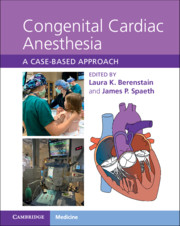
- Publisher:
- Cambridge University Press
- Online publication date:
- September 2021
- Print publication year:
- 2021
- Online ISBN:
- 9781108657341

With the number of patients living with congenital heart disease steadily increasing, relevant training in anesthesia care for these patients is becoming ever more important. Written by experts in the field, this highly illustrated book succinctly reviews the pathophysiology of congenital cardiac lesions along with important anesthetic implications for each. Case scenarios cover patients of wide-ranging ages, with a focus on care in non-cardiac operating room settings, including the general operating room, cardiac catheterization laboratory and radiology. Divided into sections corresponding to the anatomic classification of each cardiac lesion, the book includes keywords for easy cross-referencing. Several lesions have multiple scenarios presented in order to allow readers to learn how to discern more critically ill patients. The stepwise approach to understanding complex lesions provides a readily accessible guide for all anesthesia providers who care for patients with congenital heart disease. The book is also a useful tool for intraoperative teaching.
'Congenital Heart Disease A Case-Based Approach, edited by Laura Berenstain and James Spaeth, should be in the library of every pediatric anesthesia trainee and all those with a special interest in congenital heart disease in children. This book contains contributions from a host of well-known and experienced pediatric cardiac anesthesiologists. It is unique among current publications on the topic in that pathophysiology and management discussions are organized based on well-described case examples and on real world clinical situations. The book contains high quality illustrations and each chapter concludes with several current, relevant references.'
James A. DiNardo - Professor of Anaesthesia and Chief, Division of Cardiac Anesthesia, Harvard Medical School
‘Safe effective management of patients with congenital heart disease presents significant challenges to the clinical anesthesiologist due to the multiplicity of both pathologic anatomies and pathophysiologic scenarios they may precipitate. Anesthesia care of these patients spans all ages for primary cardiac surgical procedures, non-cardiac surgeries and diagnostic studies. Cardiac anesthesiology experts Laura Berenstain and James Spaeth understand the enormous challenge safe effective care of patients with congenital heart disease presents to our specialty. Providing a case-based educational approach to understanding the most effective care of this patient population, the editors have assembled a cadre of specially trained, clinically credible and savvy authors to educate us. This book provides an effective educational tool to properly arm the cardiac anesthesia practitioner.’
Alan Jay Schwartz - Department of Anesthesiology and Critical Care Medicine, The Children's Hospital of Philadelphia; Professor of Clinical Anesthesiology and Critical CarePerelman School of Medicine, University of Pennsylvania
‘The case-based approach of presenting congenital cardiac anomalies is a novel technique for presenting information on such a complex and nuanced topic. The target audience is the practitioner with low-volume exposure to patients with congenital anomalies and, as such, is an excellent resource. It not only provides the background physiology, but also the salient clinical pearls that are necessary to guide appropriate anesthetic care to these complex patients.’
Robert R. Gaiser Source: Doody's Listings
‘This is not a comprehensive textbook of pediatric cardiac anesthesiology. You won’t find detailed listings of pharmacologic agents, dosing schema, and their cardiac effects or the embryologic underpinnings of AV canal defects. It is aimed instead at the much larger audience of the general pediatric or adult anesthesiologist who has 10 min to review for an upcoming case and needs a quick refresher on the anatomy, physiology, and implications of pediatric cardiac disease or for the adult cardiac anesthesiologist who is asked to care for a patient previously treated in a pediatric cardiac center now presenting emergently for a heart transplant or for adult congenital heart surgery. Given the ubiquitous nature of information today and the ready access to the internet in almost every operating location in the world, it is rare that I recommend a textbook to the trainees in pediatric anesthesia I work with daily.’
David F. Vener Source: Reviews of Educational Material
‘Drs. Laura K. Berenstain and James P. Spaeth have edited a new book that helps navigate this challenging field in a case-based format that skillfully marries anatomy, physiology, and goal-directed care in a beautifully produced text. Each chapter opens with a brief clinical scenario summarizing the patient and planned procedure and their underlying cardiac diagnosis. The extremely well-written text is accompanied by the thoughtful use of diagrams, illustrations, and photographs to outline various anatomic and physiologic elements accompanying the cardiac defects … it is rare that I recommend a textbook to the trainees in pediatric anesthesia I work with daily. This text, however, is an exception and should be readily available for reference.’
David F. Vener Source: Reviews of Educational Material
 Loading metrics...
Loading metrics...
* Views captured on Cambridge Core between #date#. This data will be updated every 24 hours.
Usage data cannot currently be displayed.